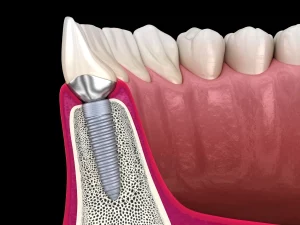
In recent years, the dental implant market has experienced explosive growth, gradually becoming the mainstream choice in dental treatments. This growth trend can be attributed to continuous advancements in implant technology and the increasing demand for oral health and aesthetics. Compared to traditional dentures, implants offer better functionality, comfort, and aesthetics, effectively restoring patients’ chewing function and confidence, which is why they are increasingly favored by both patients and dentists.
However, the high treatment costs have been a major barrier to the widespread adoption of implants. The cost of a single implant, often exceeding a thousand dollars, has deterred many patients. Finding ways to reduce implant costs and make this advanced dental technology accessible to more patients is a pressing issue in the industry. This article will explore the growth trends of dental implants, analyze their cost components, and propose feasible solutions to lower implant costs, providing affordable implant solutions for patients.
Why Choose Dental Implants?
Dental implants are the ideal solution for missing teeth, offering exceptional functionality, a natural appearance, and long-lasting durability, providing patients with an all-around improvement. Compared to traditional dentures, implants are directly embedded into the jawbone and integrate perfectly with the body’s tissues, offering chewing power and stability comparable to natural teeth, allowing you to fully enjoy the pleasures of food. At the same time, implants have a lifelike appearance that is almost indistinguishable from natural teeth, effectively improving facial aesthetics and restoring a confident smile. Moreover, implants have a long lifespan and, with proper care, can last a lifetime, eliminating the hassle of regular replacements needed with traditional dentures.
Dental implants not only restore teeth but also enhance quality of life. They improve chewing function, promote nutrient absorption, and maintain oral health. In addition, the confident smile and clear speech that implants bring enhance the patient’s social interactions and overall life quality.
When compared to traditional dentures, dental implants have clear advantages. Traditional dentures rely on the gums and adjacent teeth for support, which can lead to looseness and detachment, affecting chewing and speech. In contrast, implants provide independent support, without damaging neighboring teeth, offering a more comfortable and stable user experience.
Factors Affecting the Cost of Dental Implants
The cost of dental implants is not fixed and is influenced by various factors. The main factors include the following:
1. Material Selection
The material of the implant is one of the key factors affecting cost. Common implant materials on the market are pure titanium and titanium alloys. Pure titanium has excellent biocompatibility but is relatively expensive. Titanium alloys, while maintaining good biocompatibility, reduce costs but may be slightly less strong than pure titanium. Additionally, the coating technology on the implant surface and the materials used for connecting components can also affect the final price. Choosing high-quality implants means a longer lifespan and lower risk of complications, but it also involves higher investment costs.
2. Technology and Manufacturing Process
Dental implant technology has continually evolved, offering patients more options, from traditional two-stage implants to immediate implants and immediate loading. Advanced techniques can shorten the treatment period, reduce surgical trauma, and improve the success rate of implants, but they also require higher technical costs and more expensive equipment, which will be reflected in the overall treatment cost.
3. Surgical Difficulty and Post-Treatment Care Costs
Each patient’s oral condition is unique, and the difficulty of the implant procedure can vary. For example, patients with insufficient bone mass may require bone grafting procedures, which will undoubtedly increase the complexity of the surgery and treatment costs. Furthermore, regular follow-up visits, maintenance, and potential complications after the implant procedure will incur additional costs.
In summary, the cost of dental implants is influenced by various factors, such as materials, technology, and the difficulty of the surgery. When choosing an implant, patients should consider their own situation, financial ability, and the recommendations of their dentist to select the most suitable treatment plan.
How to Choose Affordable Dental Implants Without Sacrificing Quality?
- Choose High-Value Implant Brands While there are many implant brands on the market, not all of them can control costs while maintaining quality. DentalMaster is a typical example of a high-value brand. This brand offers high-quality implant systems that combine advanced technology and materials to ensure stable and durable implant outcomes, all while being reasonably priced—ideal for patients with a limited budget.
The design of DentalMaster implants is meticulously optimized to ensure compatibility with multiple mainstream implant brands, allowing patients to choose different treatment options while saving costs without compromising quality. - Choose a Compatible Implant System Compatibility is a crucial factor when selecting dental implants. Choosing a compatible implant brand ensures that patients can achieve the same high-quality results across different treatment options while controlling costs. For example, DentalMaster implants are compatible with well-known implant systems such as Noble and Bicon, offering dentists more flexible choices and ensuring stable and efficient results for patients over the long term.
Compatible systems not only ensure treatment accuracy but also reduce additional treatment costs, providing patients with a more cost-effective solution. - Choose Implants that Offer Long-Term Value When selecting affordable implants, it’s important to consider not only the initial cost but also the long-term value. Some high-value implants help patients save on treatment costs while reducing the hassle of frequent replacements. The long-term performance and low maintenance costs of these implants mean that patients can achieve a higher return on investment while keeping long-term expenses lower.
Additionally, the quality of the implant directly impacts the treatment outcome and the patient’s quality of life. High-quality implants integrate better with the bone tissue, reduce the risk of complications, and lower the need for subsequent treatments. Therefore, when choosing, dentists should balance cost and quality, opting for implants that offer long-term reliability and stability.
How Clinics Can Provide More Affordable Options for Patients
High medical costs are a common challenge faced by many patients. To alleviate the financial burden on patients, we can focus on the following areas to offer them more affordable options:
1. Offer Flexible Payment Plans or Installment Options:
- Installments: Spread large medical expenses over several months or even years to ease the burden of paying all at once. For example, offer 6-month, 12-month, or 24-month interest-free or low-interest installment plans.
- Income-Based Payment Plans: Create personalized payment plans based on the patient’s income level, ensuring that they can afford the medical expenses.
- Prepayment Discounts: Encourage patients to pay part or all of the fees upfront by offering discounts for early payment.
2. Insurance Coverage and How to Use Insurance to Lower Patient Costs:
- Partnerships with Insurance Companies: Establish partnerships with more insurance companies to expand coverage, allowing more patients to benefit from insurance reimbursement.
- Insurance Consultation Services: Assist patients in understanding their insurance benefits and guide them on how to maximize their coverage to lower medical costs.
- Simplify Insurance Claims Process: Optimize the insurance claims process to reduce claim time and ease the financial burden on patients.
3. Collaborate with Other Healthcare Providers to Reduce Overall Treatment Costs for Patients:
- Referral Networks: Partner with cost-effective healthcare providers such as independent imaging centers and laboratories, offering patients more affordable diagnostic and treatment services.
- Integrated Healthcare Services: Integrate resources from different healthcare providers to avoid redundant tests and treatments, reducing overall treatment costs for patients.
- Explore Telemedicine: Use telemedicine technologies to provide patients with more convenient and affordable healthcare services, such as online consultations and remote diagnostics.
How to Balance “Affordable” and “High Quality”?
In the healthcare industry, finding ways to offer affordable treatment options without compromising quality has always been a key topic of discussion. Particularly when it comes to dental implants, long-term research and numerous successful cases have shown that high-quality and reasonably priced implants can deliver excellent treatment results. To achieve this goal, healthcare providers must not only select top-quality implant materials and advanced technologies but also offer ongoing patient support and follow-up services. Regular check-ups, professional guidance, and necessary maintenance can significantly improve implant success rates, enhance patient satisfaction, and ultimately strike the perfect balance between “Affordable” and “High Quality.”
Conclusion
The dental implant market has experienced significant growth, driven by advancements in technology and a growing demand for better oral health and aesthetics. While the high cost of dental implants can be a barrier for many, there are viable solutions to make affordable dental implants accessible without compromising quality. By choosing high-value implant brands, such as DentalMaster, and opting for compatible implant systems, patients can receive exceptional treatment outcomes at a more reasonable cost.
Additionally, dental clinics can help alleviate the financial burden by offering flexible payment plans, collaborating with insurance providers, and optimizing treatment processes. These efforts can help reduce overall costs, making affordable dental implants a reality for more patients. Achieving the perfect balance between affordability and quality ensures that more people can benefit from the long-term advantages of dental implants, improving both their oral health and their quality of life. By prioritizing affordable dental implants, the industry can provide a cost-effective solution to the growing demand for reliable dental care, making advanced treatments more widely accessible.




